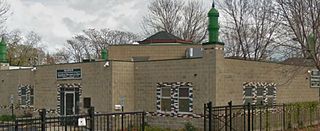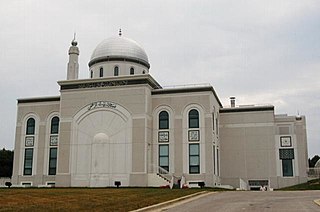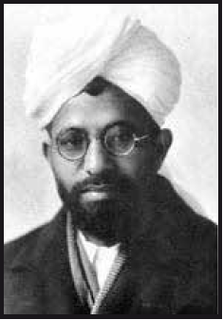
Mirza Tahir Ahmad was the fourth caliph and the head of the worldwide Ahmadiyya Muslim Community. He was elected as the fourth successor of the founder of the community, Mirza Ghulam Ahmad. He was elected on 10 June 1982, the day after the death of his predecessor, Mirza Nasir Ahmad.

Mirza Basheer-ud-Din Mahmood Ahmad, was the second caliph, leader of the worldwide Ahmadiyya Muslim Community and the eldest son of Mirza Ghulam Ahmad from his second wife, Nusrat Jahan Begum. He was elected as the second successor of Mirza Ghulam Ahmad on 14 March 1914 at the age of 25, the day after the death of his predecessor Hakim Nur-ud-Din.

The Fazl Mosque also known as The London Mosque, is the first purpose-built mosque in London, England. It was opened on 23 October 1926 in Southfields, Wandsworth. At a cost of £6,223, the construction of the mosque and the purchase of the land on which it stands, was financed by the donations of Ahmadi Muslim women in Qadian, Punjab, British India, with support from the British Muslim convert Khalid Sheldrake. Between 1984 and 2019 the Fazl Mosque was the residence of the caliphs of the Ahmadiyya Muslim Community, and therefore its de facto international headquarters. The administrative headquarters now lies at the site of the Islamabad, Tilford.

The Al Sadiq Mosque was commissioned in 1922 in the Bronzeville neighborhood in city of Chicago. The Al-Sadiq Mosque is one of America's earliest built mosques and the oldest standing mosque in the country today. This mosque was funded with the money predominantly donated by African-American Ahmadi Muslim converts.

Islam is a minority religion in the island nation Tuvalu. With the introduction of Ahmadiyya 'Islam' in 1985 by Ahmadi Muslims, there are approximately 50 Ahmadi 'Muslims' in the country, of which all are members of the Ahmadiyya movement. Due to the country's small population, this represents 0.5% of Tuvalu. The Tuvalu Mosque, in Funafuti, the capital of Tuvalu, is the only mosque in the country.

Baitur Rehman Mosque is located in Silver Spring, Maryland in the United States. The mosque was inaugurated by Mirza Tahir Ahmad, the late head of the Ahmadiyya Muslim Community, on October 14, 1994. The mosque is run by the Ahmadiyya Muslim Community. An estimated 5,000 Ahmadis and guests from across the United States attended the opening ceremony.

Ahmadiyya, officially the Ahmadiyya Muslim Community or the Ahmadiyya Muslim Jama'at, is an Islamic revival or messianic movement originating in Punjab, British India, in the late 19th century. It was founded by Mirza Ghulam Ahmad (1835–1908), who claimed to have been divinely appointed as both the Promised Mahdi and Messiah expected by Muslims to appear towards the end times and bring about, by peaceful means, the final triumph of Islam; as well as to embody, in this capacity, the expected eschatological figure of other major religious traditions. Adherents of the Ahmadiyya—a term adopted expressly in reference to Muhammad's alternative name Aḥmad—are known as Ahmadi Muslims or simply Ahmadis.

Ahmadiyya in Israel is a small community in Israel. The Community was first established in the region in the 1920s, in what was then the British Mandate of Palestine. Israel is the only country in the Middle East where Ahmadis can openly practice their faith. As such, Kababir, a neighbourhood on Mount Carmel in Haifa, Israel, acts as the Middle East headquarters of the Community. It is unknown how many Israeli Ahmadis there are, although it is estimated there are about 2,200 Ahmadis in Kababir alone.

Ahmadiyya Muslim Community was established in United Kingdom with the pioneering efforts of Chaudhry Fateh Muhammad Sial, who arrived in London in July in 1913. Sial was the first missionary sent overseas by the Ahmadiyya Muslim Community and was under the direction of Hakeem Noor-ud-Din, the first caliph of the movement.

Abdur Rahim Dard, known as A. R. Dard was an Ahmadi Muslim writer, missionary, and political activist for the Pakistan Movement, who served as the Imam of the historic Fazl Mosque, the premier gathering place for Indian Muslims regardless of denomination in London. He is known for convincing Muhammad Ali Jinnah to return to British India and fight for the Pakistan Movement.

Ahmadiyya is an Islamic religious movement originating in 1889 in northern India around the teachings of Mirza Ghulam Ahmad (1835–1908), who claimed to have been divinely appointed as both the promised Mahdi and Messiah expected by Muslims to appear towards the end times.

Mufti Muhammad Sadiq was a companion of Mirza Ghulam Ahmad and the first Muslim missionary in the United States, converted over seven hundred Americans to Islam directly and over thousand indirectly. His purpose, as a representative of the Ahmadiyya Movement in Islam, was to convert Americans to Islam and clear general misconceptions about it. Something that separated Mutfi Muhammad Sadiq from his contemporaries was the belief in racial integration between all racial and ethnic groups not just African Americans. He was also important in trying to unite a hodgepodge of Muslim immigrants from Arabs to Bosnians to build mosques and have congregational prayer especially in Detroit and Chicago.

Ahmadiyya is a persecuted branch of Islam in Saudi Arabia. Although there are many foreign workers and Saudi citizens belonging to the Ahmadiyya movement in Saudi Arabia, Ahmadis are officially banned from entering the country and from performing the pilgrimage to Mecca and Medina. This has led to criticisms from multiple human rights organizations.

Ahmadiyya is an Islamic branch in the United States. The earliest contact between the American people and the Ahmadiyya movement in Islam was during the lifetime of Mirza Ghulam Ahmad. In 1911, during the era of the First Caliphate of the Community, the Ahmadiyya movement in India began to prepare for its mission to the United States. However, it was not until 1920, during the era of the Second Caliphate, that Mufti Muhammad Sadiq, under the directive of the caliph, would leave England on SS Haverford for the United States. Sadiq established the Ahmadiyya Muslim Community in the United States in 1920. The U.S. Ahmadiyya movement is considered by some historians as one of the precursors to the Civil Rights Movement in America. The Community was the most influential Muslim community in African-American Islam until the 1950s. Today, there are approximately 15,000 to 20,000 American Ahmadi Muslims spread across the country.

Ahmadiyya is an Islamic movement in Australia, first formally founded in the country in the 1980s, during the era of the fourth caliph. However, the history of the Community dates back to the early 20th century, during the lifetime of the founder of the movement, Mirza Ghulam Ahmad, with the first contacts arising as a consequence of Australians travelling to British India, and also as a consequence of early, "Afghan" camel drivers settling in Australia during the mid to late 19th century. Today there are at least four Ahmadi mosques in four of the six Australian states, representing an estimated 6,000-8,000 Australian Ahmadis in the country.

Baitus Samee Mosque is a prominent Ahmadi Muslim mosque in Houston, in the U.S. state of Texas. It was developed in stages during 1998 to 2004; its doors opened in 2001 or 2002.

There are around 70,000 Muslims in Maryland in the United States as of December 1992, according to the American Muslim Council. This is the tenth highest number of Muslims of all U.S. states, representing 1.4% of the Muslim population in the country, as well as 1.4% of the total population of Maryland, at the time of the report.

The Mubarak Mosque is a mosque in Tilford, Surrey, England. It currently serves as the mosque on the site of the international headquarters of the Ahmadiyya Muslim Community, formerly known as Islamabad. It was inaugurated on 17 May 2019 by Mirza Masroor Ahmad, the fifth caliph of the Ahmadiyya Muslim Community.












